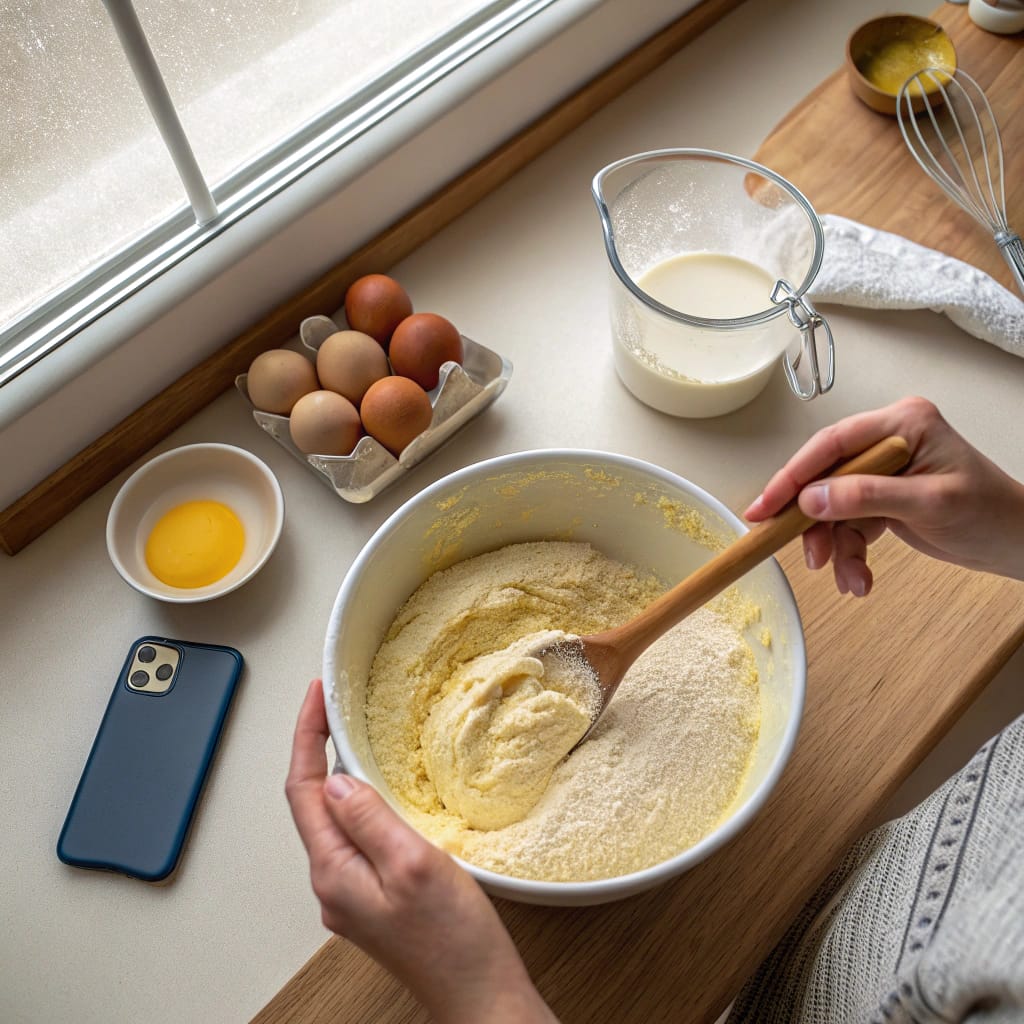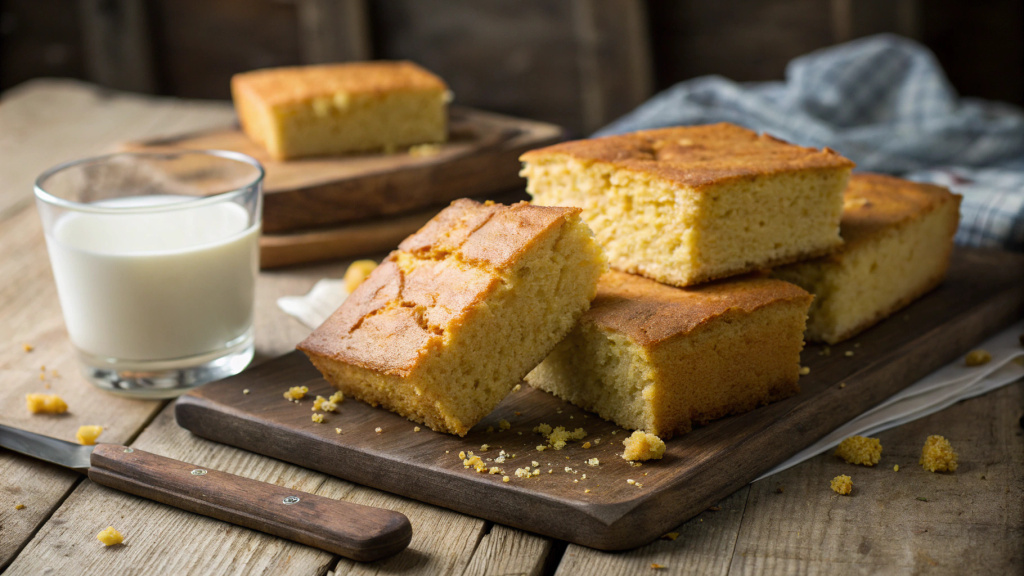Introduction to Cornbread in Buttermilk: Why This Classic Dish Works
Cornbread is a beloved dish in Southern and American cuisine, and it is often enjoyed alongside hearty meals or as a standalone treat. However, why do people put cornbread in buttermilk? This simple yet delicious combination has been a staple in many households for generations. The rich, slightly tangy flavor of the buttermilk complements the texture of the cornbread, enhancing its flavor and moisture. In this article, we’ll explore how cornbread and buttermilk came to be such a classic pairing, and we’ll share a detailed guide on how to prepare this comforting dish.
Cornbread itself has a long history, especially in Southern cooking, and when combined with buttermilk, the result is a smooth, flavorful texture that’s hard to resist. So, whether you’re curious about this classic duo or you want to perfect your recipe, keep reading for a comprehensive guide to making cornbread with buttermilk.
Essential Ingredients for Cornbread in Buttermilk Recipe
When preparing cornbread in buttermilk, you’ll need a few simple ingredients that come together to create a delicious, comforting dish. The ingredients are quite flexible, and you can adjust them according to your taste. But, why do people put cornbread in buttermilk? It’s because buttermilk adds richness, moisture, and a slight tang to the cornbread, making it incredibly flavorful. Below is a list of essential ingredients for the perfect buttermilk cornbread recipe:
- Cornmeal: This is the base of your cornbread and gives it the signature texture.
- All-purpose flour: Flour helps to bind the ingredients together and gives the cornbread structure.
- Buttermilk: The key ingredient that adds richness and tang to the cornbread.
- Eggs: Eggs provide structure and help with the rise of the cornbread.
- Baking powder: This leavening agent helps the cornbread to rise and become fluffy.
- Sugar: A little sugar balances the savory flavors of the cornbread.
- Salt: Salt enhances the flavors and brings all the ingredients together.
- Butter: Butter adds richness and helps create a tender texture in the cornbread.
These basic ingredients come together to create a flavor-packed cornbread. However, you can also experiment with additional seasonings or ingredients to make it your own. So, why do people put cornbread in buttermilk? It’s because buttermilk not only enhances flavor but also improves the texture, ensuring a moist, tender crumb.
Tools Needed for Making Cornbread in Buttermilk
To make cornbread in buttermilk, you’ll need a few essential kitchen tools. These will ensure your recipe is successful and that you get the perfect cornbread every time. Here are the tools you should have on hand:
- Mixing bowls: To combine the dry and wet ingredients.
- Measuring cups and spoons: For precise measurements of the ingredients.
- Whisk: For mixing the wet and dry ingredients together.
- 9×9-inch baking pan: A square pan works well for even baking.
- Spatula: To scrape the sides of the bowl and ensure all ingredients are mixed evenly.
- Oven: Of course, a preheated oven is necessary for baking your cornbread.
These tools are all simple and easy to find, making the preparation process hassle-free. Once you have them, you’re ready to dive into the preparation steps.
Step-by-Step Guide to Preparing Cornbread in Buttermilk
Making cornbread in buttermilk is easy, but it’s important to follow each step carefully to achieve the perfect texture and flavor. You may be wondering, why do people put cornbread in buttermilk? The answer lies in the way buttermilk enhances the flavor and moisture of the cornbread, making it incredibly tender and rich. Below is a step-by-step guide to help you make cornbread that’s moist, fluffy, and delicious. As you follow these steps, you’ll start to understand why people put cornbread in buttermilk – it’s all about creating the perfect balance between the tanginess of the buttermilk and the cornmeal’s texture. This combination results in a cornbread that’s not only flavorful but also has a delightful crumb. So, let’s dive into the recipe and see exactly how this classic dish comes together!
Preparing the Ingredients
- Preheat the oven: Set your oven to 400°F (200°C). This high temperature will help the cornbread achieve a golden-brown crust.
- Grease your baking pan: Lightly grease your 9×9-inch baking pan with butter or cooking spray. This prevents the cornbread from sticking.
- Combine dry ingredients: In a large mixing bowl, whisk together the cornmeal, all-purpose flour, sugar, baking powder, and salt.
- Mix wet ingredients: In another bowl, beat the eggs and add in the buttermilk. Mix until the eggs are fully incorporated into the buttermilk.
- Add melted butter: Stir in the melted butter into the wet ingredients for added richness.

Cooking
- Combine wet and dry ingredients: Gradually pour the wet ingredients into the dry ingredients. Use a spatula or spoon to gently fold the ingredients together. Be careful not to overmix; the batter should remain slightly lumpy.
- Pour the batter into the pan: Transfer the batter into your prepared pan. Smooth the top with a spatula.
- Bake the cornbread: Place the pan in the oven and bake for 20-25 minutes or until the top is golden brown and a toothpick inserted into the center comes out clean.
Simmering and Adding Flavor
- Check for doneness: After the recommended baking time, check the cornbread for doneness. If needed, let it bake for an additional 5 minutes.
- Cool slightly: Let the cornbread cool in the pan for about 10 minutes before slicing. This helps the cornbread firm up and makes it easier to cut.
“Discover the perfect recipe for Buttermilk Cornbread and explore how it enhances the texture and flavor of your meals. For more variations, check out our Cornbread with Buttermilk or Milk guide.”
Delicious Variations of the Classic Cornbread in Buttermilk Recipe
While the classic cornbread in buttermilk recipe is a favorite, there are numerous variations you can try to add your own twist. Here are some ideas to get you started:
- Jalapeño cornbread: Add finely chopped jalapeños for a spicy kick.
- Cheddar cornbread: Stir in shredded cheddar cheese for a savory addition.
- Honey cornbread: Drizzle honey into the batter or on top of the finished cornbread for a sweet contrast.
- Bacon cornbread: Add cooked, crumbled bacon for a savory and smoky flavor.
- Cornbread muffins: Instead of baking the batter in a pan, portion it out into muffin tins for individual servings.
These variations offer flexibility while keeping the essence of the traditional recipe intact. Experiment with different ingredients and flavors to suit your preferences.
One of the reasons why people put cornbread in buttermilk is because of how it creates a soft, moist texture that elevates the whole experience. When you add buttermilk to the batter, the acidity interacts with the baking powder, helping to create a light, airy crumb. This is why buttermilk cornbread is such a popular choice for many—its tenderness sets it apart from other types of cornbread. But even with the best ingredients and techniques, it’s essential to let your cornbread rest for a few minutes after baking. Allowing it to cool slightly ensures that the flavors fully develop, and the cornbread firms up, making it easier to slice. Moreover, the resting period allows the buttermilk to continue absorbing into the cornmeal, enhancing the flavor. With these small adjustments, your cornbread will have the perfect texture and taste, leaving you with a moist, flavorful dish every time.
“Looking for a unique twist on traditional desserts? Try our Blueberry Pound Cake Recipe, a moist and flavorful treat. Or, if you’re after a more classic version, visit our Old Fashioned Blueberry Pound Cake page for the perfect nostalgic flavor.”
Common Mistakes and How to Avoid Them
Even experienced cooks can make mistakes when making cornbread in buttermilk. Below are some common mistakes and tips on how to avoid them:
- Overmixing the batter: Mixing the batter too much can result in dense cornbread. Remember, a lumpy batter is fine!
- Not greasing the pan properly: If your pan isn’t greased well, the cornbread may stick. Be sure to grease the pan generously.
- Not preheating the oven: Always preheat the oven to ensure that the cornbread bakes evenly from the start.
- Using the wrong type of cornmeal: For the best texture, use medium or fine ground cornmeal, not coarsely ground.
- Not checking doneness: Always check the cornbread with a toothpick to ensure it’s cooked through.
By being aware of these potential mistakes, you can easily avoid them and bake the perfect cornbread every time.
Another tip for making perfect cornbread in buttermilk is to allow the batter to rest for a few minutes before baking. This resting period helps the ingredients meld together, allowing the cornmeal to absorb the buttermilk and other liquids. As a result, the cornbread will have a more tender crumb and a better texture. Additionally, if you want your cornbread to have a slightly crisper crust, you can preheat your baking pan in the oven before adding the batter. This creates a quick sear on the bottom of the cornbread, giving it an extra layer of crispiness. However, be cautious not to overbake the cornbread, as this can cause the edges to become too hard. Once you’ve achieved the perfect balance, you’ll find that these small steps make a significant difference in the final product, resulting in a cornbread that’s both delicious and visually appealing.
Nutritional Benefits
Cornbread, especially when made with buttermilk, can provide some nutritional benefits. While it’s often considered comfort food, it also contains some important nutrients:
- Calcium: Buttermilk is rich in calcium, which is important for strong bones and teeth.
- Fiber: Cornmeal is high in fiber, which supports digestive health.
- Protein: Eggs and milk (or buttermilk) contribute a moderate amount of protein, which is essential for muscle growth and repair.
- Vitamins: Cornbread contains several B vitamins, which help in energy production and metabolism.
Of course, cornbread is best enjoyed in moderation, as it can be high in calories due to its butter and sugar content. However, by making healthier variations (like using whole wheat flour), you can further boost its nutritional profile.
Pairing with Sides and Drinks
Cornbread in buttermilk pairs wonderfully with a variety of dishes. It’s versatile and complements both savory and sweet foods. Here are some great pairing ideas:
Sides:
- Collard greens: A Southern classic, collard greens pair perfectly with the richness of cornbread.
- Fried chicken: The crispy texture and seasoning of fried chicken make it a perfect match for soft, moist cornbread.
- Chili: Cornbread is often served alongside a hearty bowl of chili, where it soaks up the flavorful sauce.
- Grilled vegetables: Serve your cornbread alongside grilled veggies for a light yet satisfying meal.
Drinks:
- Iced tea: A classic Southern drink that pairs wonderfully with cornbread.
- Lemonade: The tartness of lemonade balances the richness of the cornbread.
- Beer: A light lager or ale complements the flavor of cornbread without overpowering it.
These pairings help elevate the meal and offer a variety of flavor combinations to suit your preferences.
Conclusion: A Simple and Versatile Recipe
In conclusion, cornbread in buttermilk is a simple yet versatile recipe that has stood the test of time. Whether you enjoy it on its own or paired with your favorite dishes, this comforting food brings warmth and flavor to any meal. With the easy-to-follow instructions and potential variations, you can make cornbread that suits your taste and dietary needs.


2 thoughts on ““Why Cornbread and Buttermilk Make the Perfect Pairing: A Southern Classic””